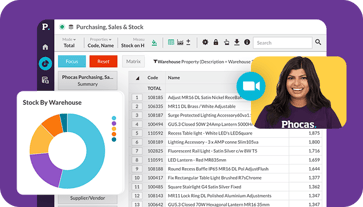How can business intelligence better inform sales, marketing, finance and executives?
At the heart of BI is the ability to turn raw data into actionable insights. How can these insights be used to help sales, marketing, finance and company executives make better decisions?
NB: This is an excerpt from our white paper: ''Eight keys to achieving business intelligence success in 2017". To download the full white paper, click here.
The key word is actionable.
Actionable data is defined as “information that can be acted upon or information that gives enough insight into the future that the actions that should be taken become clear for decisions makers.”
This is data that has already been analyzed and processed and is now presented in clear and concise way. The analysis leaves no doubt what should be done next, and perhaps more importantly, it places a level of accountability on everyone who accesses and uses the BI system.
Once you have run your reports, created your dashboard and analyzed the data, your team will have a clear understanding of what needs to happen with customers, products, marketing, inventory, the regions or across the business.
Companies are using actionable insights to inform the following areas of their business:
1. Sales strategy
Your BI system is helping your sales team discover sales trends and opportunities based on customers’ buying habits, promotional success, shopping experience and other customer experiences. With this knowledge, the responsibility falls on the sales team to decide the best course of action to continue working with the customer, deliver more effective promotions and improve sales.
2. Marketing
BI helps identify promotional returns and analyze campaign outcomes. The marketing team is accountable for using the results to make decisions to optimize marketing strategies and produce a better return on investment.
3. Finance
BI provides a real-time view of a company’s financial situation, including profit and loss, general ledger and balance sheets. By examining incoming and outgoing finances of the present and past, financial leaders can implement strategies that can benefit the financial future of their business. The data and future results will hold these leaders responsible for their decisions.
4. Executive decision-making
BI provides the statistical facts that executive teams need to help guide their overarching business strategies. BI also delivers a clear and comprehensive picture of the business performance, as well as key insights into individual areas of the business from employee management and recruiting, to supply chain and finance. Armed with these insights, executives can set business KPIs that align with business goals to help their team stay focused and on track.
These are just a few ways that companies are using BI to make more intelligent business decisions. Ultimately, your BI system will help guide your executives, managers and staff in making the best decisions they can for the company.
As your team embraces a data-driven culture and the quality of data continues to improve, your reporting and analysis will also improve, resulting in more timely and strategic business decisions.


Empowering businesses with intuitive data analytics, driving informed decisions for growth and profitability. We make people feel good about data.
Related blog posts

How can you maximize the business benefits from your enterprise resource planning (ERP) system? You get there by rethinking ERP reporting as a layered reporting system that turns ERP data into real-time insights, not just historical outputs. For years, enterprise resource planning platforms have been the backbone of manufacturing, distribution and retail because they capture orders, inventory, invoices and financial data in one place. Yet the price and effort of implementing ERP software has often led business people to question whether the company is getting the value they expected. It depends on how well people can access, analyze and act on the information inside the ERP system and related data sources.
Read more
Customer segmentation has been around for decades, but in many organizations, it’s still underutilized. Done right, it’s one of the most powerful tools to help sales teams focus their time and energy, optimize resources and improve the customer experience.
Read more
Financial planning and analysis (FP&A) provides the insights that drive growth, protect profitability and guide new investments. Done well, FP&A transforms raw financial data into scenario models and forecasts, helping finance leaders and business units move ahead with confidence.
Read more
Picture a football coach preparing for the big game. He watches game‑tape, studying player metrics, analyzing every play and using real‑time stats to inform strategy. That’s exactly how sales managers and sales leaders should approach their coaching program—with a data‑driven approach.
Read moreBrowse by category

Find out how our platform gives you the visibility you need to get more done.
Get your demo today